Possible growing problems
The main problems when growing the VaT Tsar Pea variety are similar to those that arise when caring for other varieties of indoor Saintpaulias.
Leaf problems
The following problems are possible:
- Sluggish, drooping leaves indicate that the flower has not been watered for a long time. Do not immediately pour a lot of water over the violet. After drying out, watering is carried out gradually, starting with small doses, which gradually increase and reach the normal level. Such a problem with leaves occurs when overflowing violets.
- Salt deposits on the leaves can be removed with sphagnum, which is placed on top of the soil.
- The leaves are shrinking due to the fact that the soil is not sufficiently rich in nutrients. The best option is to transplant into a new substrate.
- Leaves curl due to heat or overheating. The flower should be placed in a shaded, cooler room. Damaged parts can be removed and transplanting into new soil may be required.
- If the cuttings are stretched, then they do not have enough light.
- Leaf spots are caused by water droplets on the leaves or cold.
These are the main difficulties that can arise with leaves. If you follow the rules for caring for the plant, then they will not arise.
Pests
Of the pests, saintpaulias are most often disturbed by:
- mealybug;
- ticks;
- aphid;
- nematodes.
If signs of the appearance of these insects are found, urgent insecticide treatment will be required. But you need to be careful with their dosage, since the violet is very sensitive to the introduction of chemical elements.
Diseases
The most common diseases:
- root and stem rot;
- rust of leaves;
- powdery mildew;
- late blight;
- fusarium;
- vascular bacteriosis.
Important! To combat diseases, you need to identify the causes of their occurrence. It is imperative that a transplant into a new soil is required, the removal of all infected parts of the plant and a quarantine period spent in isolation from other plants
Signs of improper care
Improper care is instantly displayed on Saintpaulias, depending on the excess or lack of lighting, overflow or prolonged drought, temperature and correct humidity. If at least one of these rules is violated, the leaves and flowers become faded, drooping, change color. Flowering may not come at all. Therefore, you need to monitor sensitive violets as carefully as possible.
Violet VaT Tsar Pea is an interesting, original hybrid variety. Its flowering is spectacular and long, the flowers are large and bright with an unusual color. The plant will take its rightful place on the windowsill of any grower and will become an adornment of his collection.
vote
Article Rating
Plant care rules
This flower feels most comfortable in well-lit areas with fertile soil. In shaded areas, the bush can grow fully, but the abundance of flowering will decrease, and with excess moisture there is a danger of decay.
Watering for a fragrant violet is an optional procedure, because the bush survives even in drought, but without moisture, flowering will be very scarce or will not occur at all, and the danger of being hit by a spider mite also increases. The soil is irrigated only when necessary, avoiding the appearance of puddles.
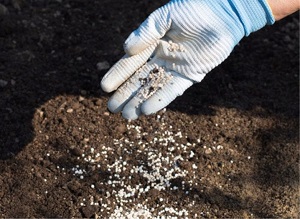 Top dressing is carried out during the period of active growth, if desired by the owner. It is recommended to use mineral fertilizers, since the plant reacts extremely negatively to fresh organic fertilizers.
Top dressing is carried out during the period of active growth, if desired by the owner. It is recommended to use mineral fertilizers, since the plant reacts extremely negatively to fresh organic fertilizers.
Cut off shoots if necessary, removing rotten, dried and excess parts. In parallel, you can propagate the bush using the vegetative method.For this, the healthy part of the stem-root is removed from the mother plant.
When transplanting, it is important to minimize damage to the root system, given the placement of the main root on the surface of the soil, it is recommended to cut the bush before digging it out (if necessary or desired). To rejuvenate the old individual, she is also sheared, leaving a rather small young pagon
To rejuvenate the old individual, it is also shaved, leaving a rather small young pagon.
Description of the variety
Saintpaulia of this variety is distinguished by large double flowers of white and yellow colors. Her petals are corrugated, with a pale pink border. In cooler weather, a slight green fringe may form on the edges. In a flower that has not bloomed to the end, the petals have a light monochromatic color. A brighter color appears during the growth and development of the plant. This happens within 2-4 days.
Violet leaf blades are slightly wavy. They have an elongated shape with raised edges. The color is medium green. Each peduncle has 3-4 buds. They are generally sturdy and will not fall apart.

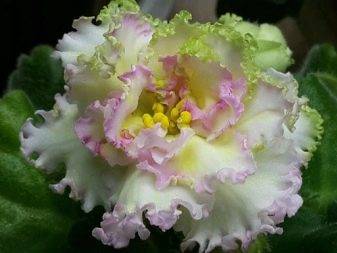
Currently, there are varieties of LE-Gold of the Scythians and AV-Gold of the Scythians. They are almost the same, although the first option most often has a brighter pink tint.
Such violets need to be transplanted only once a year. It is recommended to carry out treatment against the appearance of harmful insects and diseases twice a year.
To form a beautiful flower, you do not need to remove the petals from the central part of the rosette. Violets create the rosette and buds themselves.
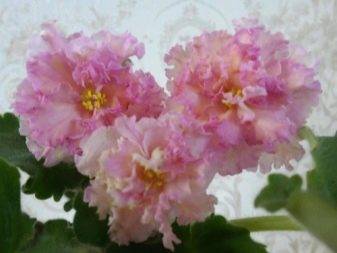
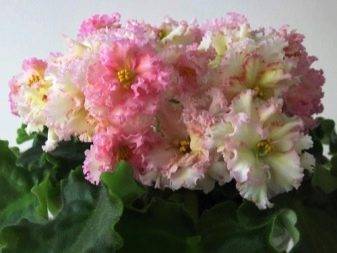
Violets "Gold of the Scythians" are fragile and delicate, they need a lot of light. Therefore, such plants can only be placed in rooms with good lighting. Otherwise, the flowers will not be able to grow and develop normally. It should be borne in mind that the best option for violets is soft diffused light. Direct rays of the sun can only harm the flowers.
Due to lack of light, violets can become dull and lethargic. Strong pulling of the cuttings can also occur. Do not forget that during the winter time you need to organize additional artificial lighting so that the indoor plants can stay in shape.
Attention should be paid to the choice of a suitable land for planting violets. It can be purchased at almost any flower shop.

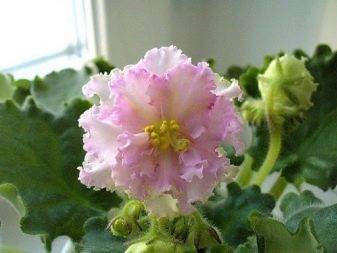
A special drainage filler should be placed at the bottom of the container in which the plant will be planted. As a rule, it is made from expanded clay. It will avoid the accumulation of a large amount of moisture in the root system of violets.
When choosing the right pot, you should consider the size. The containers for flowers are divided into several groups depending on this parameter:
- subminiature (diameter 5-7 centimeters);
- miniature (diameter 18-20 centimeters);
- large (more than 40 centimeters in diameter).
For plants of this variety, too small a container is not suitable, because this will not allow the root system to develop normally. Such options can only be used for very young violets. Adult plants are recommended to be planted in miniature pots (from the second group).

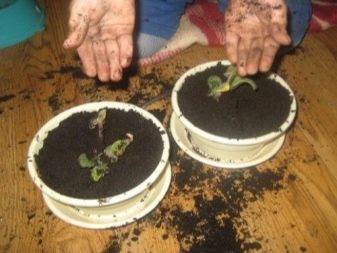
We must not forget about watering. Its frequency depends on the season (when the heat comes, it can be done a little more often). The violet should be watered at least once a week as the soil dries out. You cannot moisten a flower with a spray bottle.
Violets love high levels of humidity, so often flower growers place a separate container filled with clean water near the plant pot. You can also use a damp sponge or cloth.
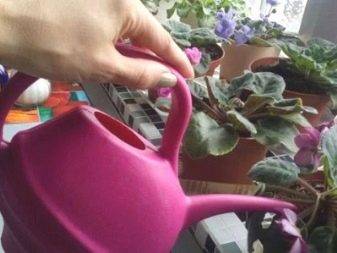
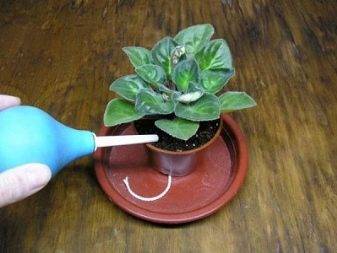
Top dressing is an important point. They need to be introduced only during the period of intensive growth and development. In winter and autumn, it is better not to fertilize the plants. For the flowering of violets, it is necessary to use phosphorus and potassium. For foliage growth, nitrogen-containing formulations should be used.
Often, due to improper care, violets can hurt.So, at low humidity in the room, leaf blades can turn yellow. If the temperature is too low, rot may appear in the root system of the plant or fusarium may develop. In such cases, all affected leaf plates are first cut off. Only after that, you can start treating violets with the help of special chemicals.

Requirements for flowering violets
In the absence of proper maintenance, Saintpaulia does not bloom, is exposed to fungal infections, and may die. It is very demanding on watering, which differs from how other indoor flowers are watered, in lighting, capacity, soil and temperature. It is necessary to regularly feed the flowers, cut, transplant only into new soil.
Genetic component
When choosing a room saintpaulia, the variety is taken into account. Breeders have bred many varieties. Among them are ampelous with small, medium or large flowers. There are violets with 5 petals, others have much more and no stamens are visible. Also, some varieties produce only 3 buds and will not bloom luxuriantly. You can wait for the violets to bloom for several months or 1.5 years. Depending on the variety, the duration of flowering is also different for them.
Finding the right container
For a small Saintpaulia, a pot 5-7 cm in diameter is suitable, for an adult flower 10-12 cm. In general, you need to look at the outlet and take a container with a diameter of half. The height should be no more than 10 cm.
Correct soil
Saintpaulias require slightly acidic soils. Get special land at a flower shop. It is not difficult to make the soil correctly, it is leafy earth, peat, charcoal, moss (1: 2: 1/2: 1/2). Or sift the garden soil by combining it with sand and baking it in the oven. Expanded clay, small pebbles are laid at the bottom. A transplant is required once a year, in a fresh substrate.
Location
Saintpaulia is located on the west or east side. In winter, there is not enough light on the windowsill from the north, in summer there is too much sun from the south, the violet is shaded or rearranged. In order to avoid hypothermia of the roots in winter, the flower is placed in a pot on a shelf, table, in a flower pot or on a wooden stand.
Lighting
Violets prefer a day of light for at least 10 hours, the light is needed diffused, the flowers shade from direct sunlight. At the same time, varieties with thick and dark leaves require more bright light than curly ones. If the flower is stretched, foliage curls, it becomes pale - there is little light, if the middle of the outlet is denser - a lot. When the leaf plates are bright, saturated in color and there are many buds on the plant, the lighting is normal.
Temperature regime
The plant loves heat. From the beginning of spring to autumn, flowers need + 20 ... + 22 ° С. In winter, not lower than + 18 ... + 20 ° С. In summer, when +30 ° С, the flower grows dull and shallow. Therefore, the room is ventilated, they use air conditioning, a split system. Drafts are not allowed in the room.
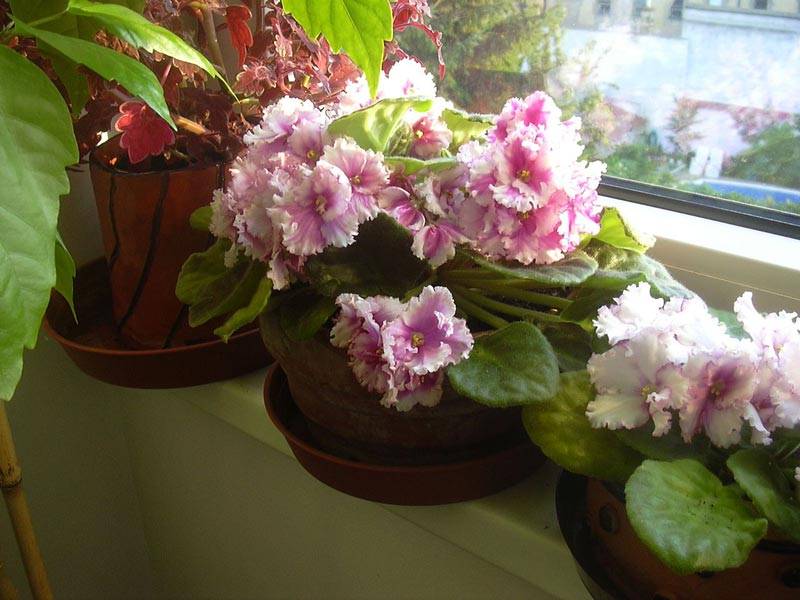
Air humidity
Violets create high humidity, 50-60%. For the winter, it is better to remove the pot from the windowsill if there is a heating system nearby. The air around the flower is sprayed without getting on the inflorescences. They put a container with a flower in a pallet with wet expanded clay, pebbles. At low humidity, the buds develop slowly.
Watering methods
There are secrets for watering Saintpaulias. The water is taken slightly warm, settled. Water as the soil dries up so that the liquid does not fall on the leaf plates, the growth point.
Through the pallet
Water at room temperature is poured into a tray at ¼ of the height of the flowerpot. Half an hour is usually enough for the plant to be saturated with moisture, this will become clear from the soil. Then the leftovers are poured off.
Drip
For him, use a watering can with a narrow spout, a syringe pear. If nothing else, a plastic bottle will do, where a hole is made in the lid and a straw is inserted. When water begins to flow out of the drain, watering is stopped and then drained.If moisture gets on the leaves, they are blotted with a dry napkin.
Wick
In the summer, when it is necessary to leave and there is no one to care for the flowers, this method is suitable.
A thin cord is placed in the pot (household cord, acrylic thread, shoe), one end of it comes out through the drainage hole, the second is folded in a ring in the middle of the ground. They put the pot on top of a bowl of water covered with a lid, the wick is lowered, while the soil collects the required amount of liquid.
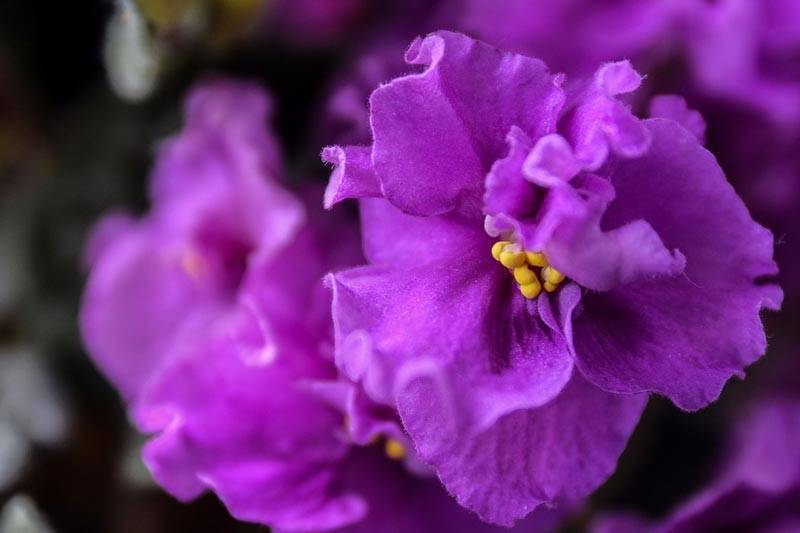
Basic rules of care
The incised violet is perfect for indoor floriculture. At home, this plant blooms and reproduces well.
Lighting and temperature
Violet loves light, but cannot stand direct sunlight. An ideal place for growing a flower can be the east window; in the west, the bright midday sun can burn the delicate parts of the plant.
The plant grows well at normal room temperature. When diluting it, conditions below + 15˚C and above + 25˚C are undesirable. The flower does not tolerate sudden day and night temperature drops.
What kind of soil does he prefer?
In nature, the flower grows in places with poor but well-ventilated soil. This determines the choice of soil. The soil for violets should be light, porous, breathable and absorb moisture.
When compiling a soil for a flower, the following components are used:
- nutritious soil (leafy soil with the addition of humus) - 30%;
- peat (horse) - 20%;
- coarse sand - 30%;
- baking powder (perlite or vermiculite - 10%);
- charcoal or chopped sphagnum moss - 10%.
An incised violet needs light, well-drained soil.
As you can see from the list, the lack of one component of the mixture can be filled with similar others. Before use, the soil is disinfected by heating in an oven at t 100˚C or spilled with a phytosporin solution.
An important factor is soil acidity. The flower can only grow on slightly acidic soils. The acidity of the soil is checked with litmus paper. With increased acidity, the substrate is supplemented with dolomite flour.
Pot selection
The root system of a flower does not grow deeper, but grows over the soil surface. In addition, it is better to plant several plants in one pot. This improves the overall look of the composition. The pot should be shallow, but with a fairly large diameter.
Influence of air humidity
The incised violet loves high air humidity, but does not tolerate moisture on the leaves and stems. Therefore, in no case should it be sprayed. If the room is too dry, the solution is to install a container of water next to the pot.
Watering and feeding
The plant prefers that the soil is always slightly moist.
Watering should be done carefully, excluding moisture on the leaves.
You can combine the top and bottom (in the pan of the pot) watering.
The flower should be fed monthly in the spring-summer period. Fertilizers are usually used complex mineral fertilizers in low concentration.
In the wild, the incised violet is extremely unpretentious. She easily tolerates drought, cold and other adverse conditions.
It is interesting! In indoor culture, the plant is very moody and requires attention.
Pruning and hygiene
No pruning is required for the flower. Remove old leaves that have lost their attractiveness. In no case should you wash the plant. In case of strong dustiness, the leaves are carefully cleaned with a brush.
Transplant, rejuvenation
The incised violet is not prone to stretching the stem, like its close relative, the Uzambara violet. Therefore, it is often not necessary to rejuvenate a flower, because the life cycle of a violet is about 10 years.
Flower transplantation is done to replace impoverished or acidified soil:
- At the bottom of the pot, expanded clay is laid in a thick layer, because the root system of the flower does not penetrate into the pot by more than 5 cm;
- Prepared soil is laid on the drainage;
- Above, again a layer of expanded clay, having made a hole in which a plant is planted.
The transplant must be done as carefully as possible, the roots of the seedling are thin and fragile
Transplanting incised violets should be done very carefully.
Description of fragrant violets
Fragrant violet is a perennial plant. It is a drug. The family is violet.
All characteristics fit in one form:
- Creeping rhizome;
- Shoots spread along the ground.
The roots of the culture give new buds every year. New violets are formed from them. Shoots are able to take root on their own. This happens according to the principle of rooting strawberries.
The fragrant garden violet has round leaves. There is a small notch at their base. During the flowering period, they bloom to full size. The classic plant variety has purple flowers with an admixture of blue.
They grow one at a time. Each has a twelve centimeter long stem. Each flower has five petals. Breeders bred a fragrant violet with pink and white inflorescences.
The aroma from them is very strong and pleasant. Wild plants grow in meadows, in ravines, in fields, in mountainous areas. The culture reproduces on its own. Therefore, at a summer cottage it may appear without the help of the owner.
The seeds are carried by ants and other insects. They live on one site for a long time. Inflorescences appear at the end of April and end in May. Some types of scented violets can bloom several times during the summer season.
This plant is considered medicinal. In most countries, violet is allowed as a medicinal product. Substances that are included in it: essential oils, saponins.
If used incorrectly, the plant can cause headaches, dizziness and nausea. Leaves, stems, flowers of culture can be medicinal.
Varieties
The fragrant violet has been studied by scientists more than once. Now garden varieties have been bred from it. They are predominantly with large and original flower shapes.
- Foxbrook Cream. White flower in the center with a yellow disc.
- Queen Charlotte. A large violet with bluish flowers.
- Red Charm. This variety is indoor and garden. The flowers are delicate with a purple tint. There is a red disc in the center.
- Bekhtles Ideal. The flowers are large, blue in color. The middle petal is slightly striped.
- Coeur d'Elsace. The flowers look wilted. They are pink in color and smell good.
Violet King Peas: variety description

Violet King Peas: photo of the variety
Violet is a very common and beautiful indoor culture. In everyday life, it is best known as a violet, but at the same time there is one subtlety: this culture has nothing to do with the violet family. True, with violets, Saintpaulias are very similar in external characteristics - the shape of flowers. In this regard, it will be more customary for us to call Saintpaulia a violet within the framework of this article. Violet king peas, which we will consider in this article, is considered one of the most famous and sought after.
Saintpaulia appeared in Europe at the end of the 19th century, and at the same time it became truly one of the most coveted plantings among many other indoor plants. Accordingly, breeders are also interested in this plant, its history and the ability to create new interesting varieties and varieties. It is worth saying that such works were crowned with success: today, more than thirty thousand varieties of these incredibly attractive plants are known. It is thanks to the labors and experiments of breeders that varieties have appeared that differ from each other in a variety of ways. This is the color of the inflorescences, the type of inflorescences, the external characteristics and shapes of the leaf plates, as well as, in general, the species and varieties differ from each other in size.
As a result, flower growers have tremendous opportunities to choose exactly those varieties and varieties of flowers that will suit their tastes and needs.Of course, flower growers also build on how this or that variety will fit into a particular interior, how it will be in harmony with certain varieties and varieties of plants. But, again, everyone's tastes are completely different, just like the understanding of which varieties are acceptable, which are easy to care for and grow, and which ones are generally best avoided, as they do not quite meet the interests and needs of those or other gardeners regarding violets as indoor plantings.
Violet Wat King Peas has a full name that looks like the violet "Wat King Peas" is a plant that, in principle, has standard sizes when comparing the variety with some other plantings. The bush rosette is incredibly attractive as it is compact and neat. The flowers are spectacular, have a pure white color, and also have purple "fingers" in the flowers, which are located on each individual petal, and give the plant even more attractive and exotic appearance. At the same time, bright pink dots-peas also seem to crumble on the purple fingers. Of course, these flowers look incredibly attractive, delicate, but at the same time very fresh.
The flowers are large, from six to seven centimeters. They are collected in a not very large hat, and at the same time the flowering is quite abundant. Another plus of this plant is that it blooms for a very long time. Violets have large and even leaves that have a delicate creamy border. Spores can bloom in 40-50% of cases, but at the same time they do not form patterns and stains on the petals that the mother shrub has. Sports are children who can be formed when gene mutation is inevitable. In this case, children do not inherit maternal traits, as well as maternal coloration, and this point should be taken into account. But it also cannot be said that this is some kind of drawback, because one way or another there are more violets, they look very gentle and attractive.
Evening primrose flower
author Petrov Yu.V., photo of the author
The nature around us is so diverse and unusual that if you look closely, you can find amazing things very close by. For example, a garden flower evening primrose, or a primrose, which has another name "night candle". I and many who saw how it blooms, do not cease to be amazed at this sight.
The genus Enotera (OENOTHERA) belongs to the willow family. There are 80 known species of evening primrose, distributed mainly in North and South America, in Europe. These are annual, biennial and perennial rhizome plants with a height of 30 to 120 cm. Large evening primrose flowers (yellow, pink or white), collected in a brush, open in the evening and at night, and during the day - only in cloudy weather.
Common types of evening primrose include:
- evening primrose drummond - an annual or biennial plant, 30 to 60 cm high, with large bright yellow flowers;
- evening primrose - biennial, up to 100 cm high, has red buds and yellow flowers;
- evening primrose - perennial, 90-120 cm high, large yellow flowers;
- evening primrose quadrangular - perennial, peduncles 45 cm high grow from a basal rosette, blooms in June-August;
- evening primrose - cultivated as a biennial, peduncles up to 25 cm high, small flowers up to 1.5 cm in diameter appear in May-June;
- evening primrose missouri - stems creeping, ascending, 30-40 cm long, with large flowers 10 cm in diameter (as a perennial, it is suitable mainly for southern regions);
- evening primrose - is grown as a biennial plant; flowers are yellowish-reddish.
For many years I have been growing the two-year-old OENOTHERA BIENNISL in the Moscow Region. The effect that it produces when blooming is comparable to a fairy tale, and remains in memory for a long time.Many years ago an acquaintance came to me with his wife and daughter about six years old. The sun was approaching the horizon when we accidentally found ourselves in the garden next to evening primrose bushes. Suddenly the evening primrose came to life: the bushes began to stir. The girl was the first to notice this. You should have seen with what delight the child, her mother and father watched how large, yellow - the colors of the sun itself - evening primrose flowers opened before their eyes! “Here's another one, and here's another, and here, and here ...”, - voices rang out. There were many buds on the evening primrose bushes. Rolled up in tubes, the buds rapidly unfolded within two to three seconds and turned into large, up to 7 cm in diameter, silky fragrant flowers shaped like a saucer. This performance lasted the whole evening - until the last flower blossomed, in which enough energy was accumulated to reveal its folded petals to the world. ... This girl has grown up. Most recently, she told me that evening primrose flowers are forever preserved in her memory - they are one of the most vivid memories of her childhood.
After night flowering, evening primrose in the morning appears in all its glory. Before lunchtime, insects have time to visit its flowering bushes. Then the flowers close and new flowers bloom in the evening. And so all summer - from June to frost. On cloudy days or in the shade, evening primrose flowers open during the day.
Evening primrose is winter- and drought-resistant. The plant is not demanding on the soil, it grows well on any - sandy loam, loam, garden soil. When planting evening primrose, it is necessary to choose a place where water does not stagnate during thaws and melting of snow in order to avoid fading out the outlets that form in the first year. Evening primrose is propagated mainly by sowing seeds in open ground in spring and early summer (from April to June) or before winter. With early sowing for seedlings or in a greenhouse, evening primrose blooms in the first year.
Evening primrose seeds are small, ripen well; remain viable for 3-4 years. Due to the small size of the seeds, in order to avoid their loss, evening primrose is more reliable to grow through seedlings. The seeds are buried 2-3 mm into the soil. Evening primrose propagates vegetatively by dividing the bush in spring (in May) or in autumn (in September-October). You can also plant young plants that appear around the mother bush.
Evening primrose is suitable for group and single plantings in the garden in a sunny or semi-shady place.
Several night candle bushes will create the illusion of an evening or night fire in your summer garden. Blooming evening primrose is very effective at night when electric lighting hits it. Add to this picture the light, with a delicate scent of lemon, the pleasant smell of evening primrose flowers, which bees and bumblebees love to visit, and you will also want to have this plant. Grow evening primrose! Rejoice! Be surprised and amazed.
The importance of proper watering at home
Water is essential for all living organisms, including plants. She is the most important building material for tissues and a supplier of nutrients needed by the plant body.
In addition, water helps maintain the microclimate around the plant. The moisture absorbed from the soil by the root system evaporates over time through the stomata on the leaves, creating a cool zone around the flower that protects it from high temperatures. Compared to the human body, this function is similar to the process of perspiration.
But water can be fatal to violets. This is due to the structure of the flower leaves. They are dense, fleshy and covered with fine villi. They save the violet from overheating and hypothermia, but, unfortunately, make it very vulnerable to burns. Direct sunlight causes spots on the leaf surface, and water droplets intensify the harmful effect several times. This is one of the main reasons for the death of violets.

Proper watering will keep the violet healthy and lush blooming.
The temperature of the water with which you water the flower is equally important. Too cold or hot water will damage the root system to the point of death.The best option is room temperature. In addition, experienced flower growers recommend that the water for irrigating violets be left standing for at least 10-12 hours.
Do not forget about the level of soil moisture. The violet is said to tolerate dryness more easily than large amounts of water. Optimal effect is not easy to achieve; it can take years of practice, trial and error. Therefore, we will try to give you the maximum of useful tips that will help you water the violet correctly so that it will delight you with bright flowering for a long time.
Types of violets in Russia
About twenty species of this plant can be found in Russia. The most common are:
- Viola Wittrock. This is the correct name for garden pansies. It is a highly branched plant 15-40 cm high. Dark green oval-shaped leaves have stipules. Viola flowers are quite large, reaching up to 10 cm in diameter. The lower petal has a spur carrying nectar and a groove in which pollen is collected. The corolla is yellow, white, blue, orange or other color. The fruit is a capsule with three chambers containing brown seeds.
- Violet marsh. A short perennial plant 5-15 cm high. These flowers are distinguished by a thin and long rhizome, spreading horizontally. Leaves are simple with stipules, growing on long petioles. The flowers are small - up to 2 cm in diameter and are usually light purple or white. When the three leaflets of the fruit capsule open, small seeds are ejected. In Russia, this plant is mainly found in the non-chernozem zone.
- Field variety. An annual or perennial herb, reaching a height of 20, and sometimes 35 cm. It has a thin brownish root, turning into straight branchy stems. Flowers are single and irregular, symmetrical only along one axis. They reach 6 to 10 cm in diameter and bloom throughout the summer.
- Tricolor flowers. In everyday life, they are called pansies. They are annual or biennial herbaceous plants. Viola has a thin taproot with few tines. Several creeping or erect stems extend from the root, reaching up to 40 cm in height. At the bottom of the stem are leaves on petioles, the length of which gradually decreases towards the top of the plant. The flowers have stipules and grow on a simple frondose raceme. The fruit is a green box with three leaves.
- Fragrant violet. It is a perennial terrestrial herb that grows up to 15 cm in height. It has a thick creeping rhizome on which rosettes of basal leaves are located. Almost the entire plant is covered with large hairs. In the axils of the basal leaves, single flowers grow, located on the pedicels. This type of violet is a self-pollinated plant and the seeds are spread by ants. Viola is used as an ornamental, medicinal and melliferous plant.


